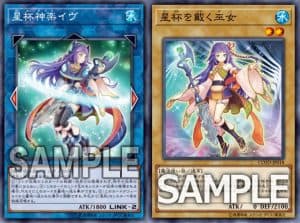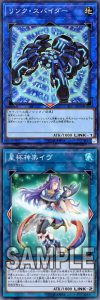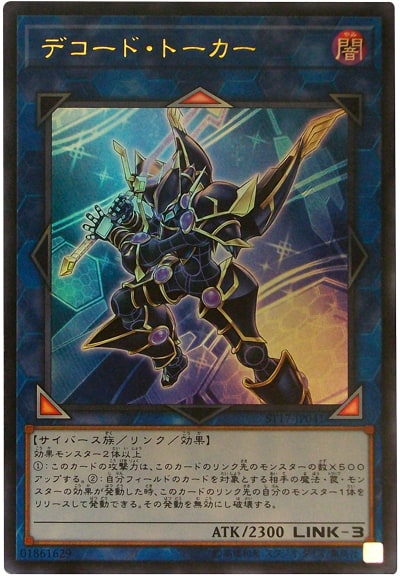You might want to read this if you want to read our site for translations of Link Cards for the next approximately three months.
Every new era of Yugioh brings in a slew of changes. Along with the new cards and rules is new card texts and terminologies to make these changes easier to understand. Those of you who have been following us to learn what Link Cards do must have seen some them. Before, terms like “Mutual Link”, “linked zone”, or even just “linked” have been thrown around in our translations, with the expectation that you, our readers, would understand them from just our explanation of the new rules and how Links work. After studying the new Perfect Rulebook and the new regular rulebook, we’ve decided to lock down and update how we’re going to translate these new terms, until the official TCG terminology comes out in July with the TCG’s Starter Deck: Link Strike. These updated translations are not official. These are just something we’re doing to in the mean time.
Link Monsters and their related rules have 5 basic terms that we can expect will be used in card texts, although only 3 have been seen so far, with one of them just describing a state on the field.
The five terms (and our translations of them) are:
リンク状態 Link Joutai (Linked State)
リンク先 Link Saki (Link Point)
リンク元 Link Moto (Link Source)
相互リンク Sougo Link (Mutual Link)
エキストラリンク Extra Link
Link Joutai literally means “a link state”. It is a situation in which a Link Monster (A) is pointing an arrow at another monster (B), like so: A -> B. You might have seen this translated as simply “linked” before, or maybe a variant of it, but we’re going to update the translation, and call this “Linked State”. This brings us to talk about the next two terms associated with this state.
Link Moto is a term that has not been seen on any card yet, and is found only the Perfect Rulebook. It literally means “where the link comes from”, so we’re calling this “Link Source“. It refers to the Link Monster in a Linked State that’s pointing an arrow to another monster. In the Link State A -> B, the Link monster (A) is the Link Source. This term isn’t too important right now because, again, it has not been seen on any cards yet, but it’s good to know about it.
Link Saki means something like “where the link is pointing at” so we’re calling this “Link Point“. In the Link State A -> B, the monster being pointed at (B) is at the Link Point. It is this interaction which most Link Monsters resolve their effects around, such as both of Decode Talker’s effects. This term was hard to nail down for our team, and you might have seen it translated in the earliest reveals of Link Monsters as simply “linked”, or “linked to”, and recently as “linked zone”. After studying the new cards and rules, we’ve decided these older terms are simply not efficient enough, and from this point on, we’re going to use the term “Link Point”.
Sougo Link is what we’ve translated as Mutual Link before, and we’re going to keep this translation. It’s a state in which 2 or more Link Monsters are pointing to each other with their Link Arrows, like so: A -> <- B.
Extra Link is the state that allows a player to use a series of Mutual Links to connect a player’s Extra Monster Zone to the other Extra Monster, in order to take both of them. We see no reason to change this term.
Now, after reading that wall of text mixed with Japanese, I’m sure there are readers are getting confused, but have no fear! I’ve brought examples to help you understand how to read these new cards.
First is “Seihai Kagura Eve”, which we’ve tentatively named “Stargrail Shrine Maiden Eve”. This is how its text will look under the new translations.
(1) This card in a Linked State cannot be destroyed by battle or card effects, also it cannot be targeted by an opponent’s card effect.
(2) If a monster at this card’s Link Point would be destroyed by battle or card effect, you can send this card to the Graveyard instead.
(3) If this card is sent from the field to the Graveyard: You can Special Summon 1 “Stargrail” monster from your hand.
The (1) effect means that if there’s a monster that Eve is pointing to with her Link Arrow, or if another Link Monster is pointing at her with its arrow, she will be immune to destruction and opponent’s targeting effects.
For example:

Eve > Stargrail-Bearing Priestess
and

Link Spider
V
Eve
would both work
The (2) effect means that if a monster that Eve’s Arrow(s) is pointing to would be destroyed, you can destroy her instead.
Second is another Stargrail monster, “Seihai Kenshi Aurum”, which we’ve tentatively named “Stargrail Swordsman Aurum”.
You can only use this card name’s (2) effect once per turn.
(1) This card gains 300 ATK for each “Starelic” monster with a different name in your Graveyard.
(2) You can Tribute 1 monster at this card’s Link Point, then target 1 monster in your Graveyard, except that monster; Special Summon it to this card’s Link Point.
(3) If this card is sent from the field to the Graveyard: You can Special Summon 1 “Stargrail” monster from your hand.
The (2) effect means you can Tribute 1 monster that Aurum’s arrow is pointing at, then target another monster in your Graveyard, and Special Summon that monster to a Monster Zone that Aurum’s pointing at with its Link Arrow.
Finally, let’s have a look at “Firewall Dragon”, Yusaku’s ace monster.
(1) Once, while this card is face-up, during either player’s turn: You can target a number of monsters on the field or in the Graveyards, up to the number of monsters in a Mutual Link with this card; return them to the hand.
(2) If a monster at this card’s Link Point is destroyed by battle, or sent to the Graveyard: You can Special Summon 1 monster from your hand.
The (1) effect allows you to target a number of monsters, up to the number of monsters that Firewall Dragon is pointing at who are also pointing back at it, and returns them to the hand. The (2) effect means if a monster that Firewall is currently pointing at either gets destroyed by battle or simply sent to the Graveyard, you can Special Summon 1 monster from your hand.
After looking at these three, it should be pretty clear how the terms are to be used in card translations.
Again, the terms are:
リンク状態: Link Joutai: Linked State
リンク先: Link Saki: Link Point
リンク元: Link Moto: Link Source
相互リンク: Sougo Link: Mutual Link
エキストラリンク: Extra Link: Extra Link
You might have also noticed that I’ve been using the term “Link Arrow” instead of the OCG term of “Link Marker” in this article, this is because the official Yugioh Database has been updated, and Link Arrow (along with Cyberse-Type) were confirmed there.
You’ll see these terms used when the rest of Code of the Duelist leaks very soon, as well as when we post up the full spoiler on the site later. And to reiterate, these are not the official TCG terms, as we have no idea what those terms are. These are just terms we’ll be using for the sake of our translations for the next 3 months, until we can get the official terms. Once we get the official terms, we’ll be switching over to those, as always.

